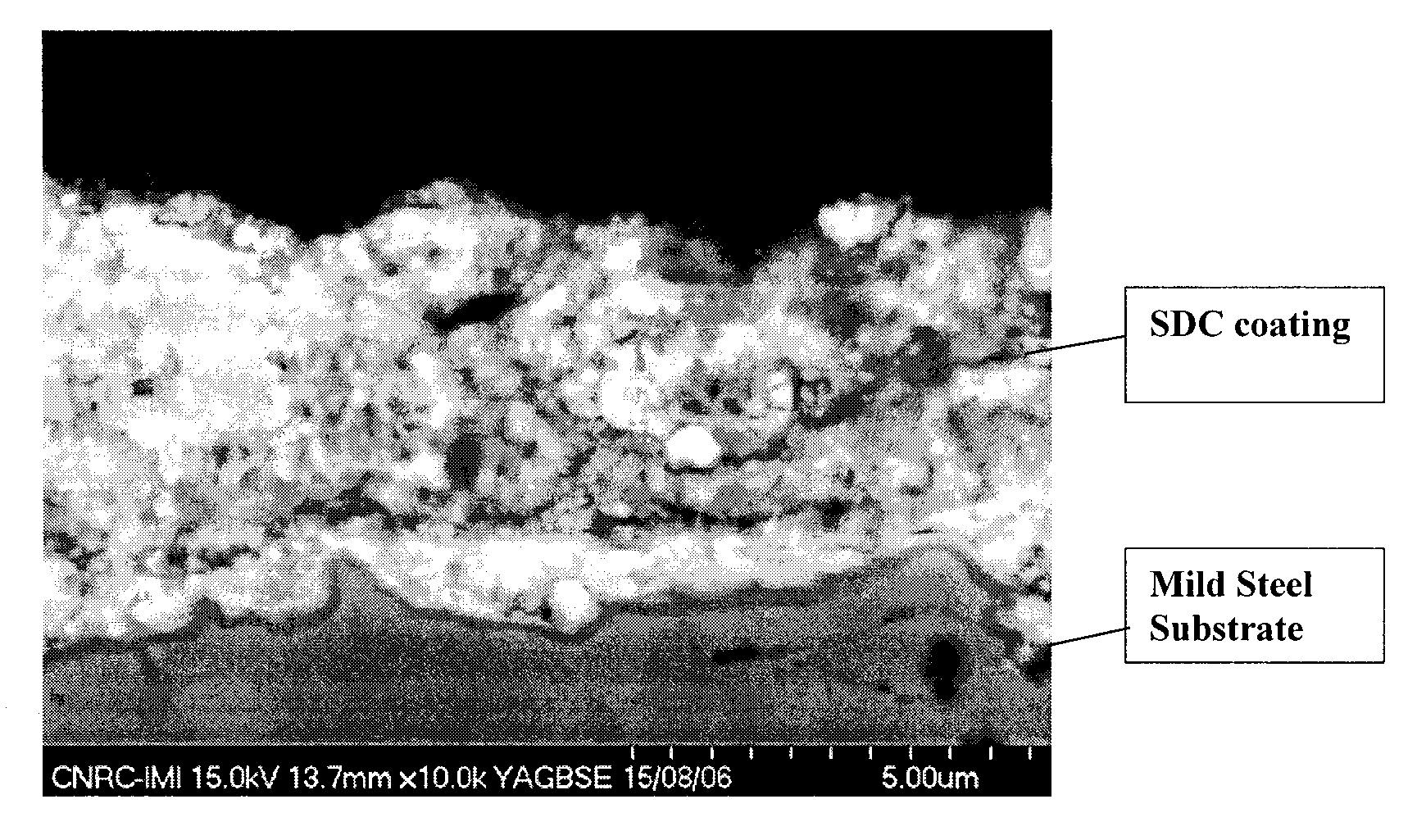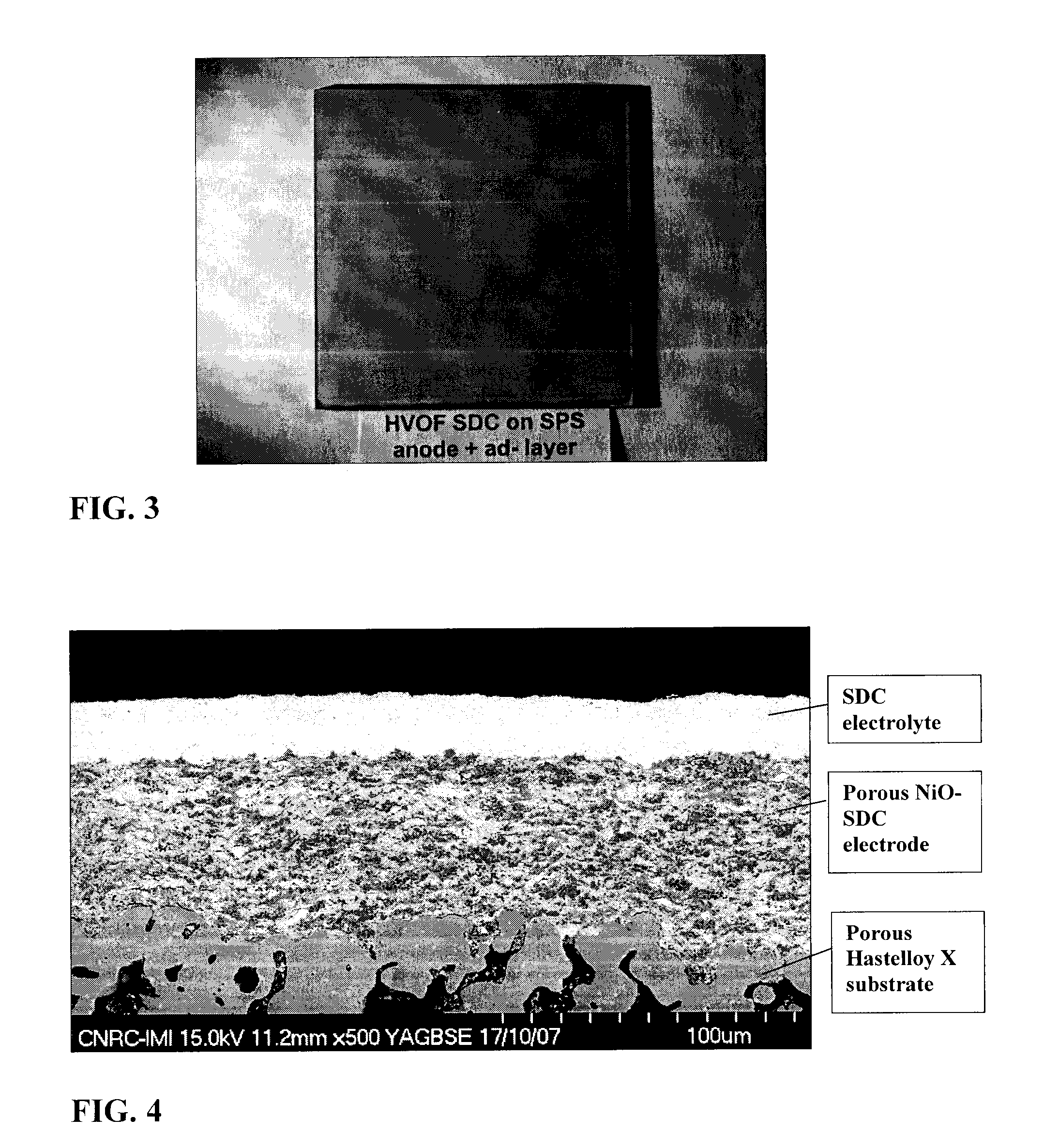Process of Making Ceria-Based Electrolyte Coating
a technology of electrolyte coating and electrolyte, which is applied in the direction of lanthanide oxide/hydroxide, final product manufacturing, sustainable manufacturing/processing, etc., can solve the problems of high material cost and high overall fabrication cost, and cannot be supported by metallic components or otherwise integrated, so as to reduce gas leakage
- Summary
- Abstract
- Description
- Claims
- Application Information
AI Technical Summary
Benefits of technology
Problems solved by technology
Method used
Image
Examples
example 1
HVOF Sprayed Electrolyte
Apparatus
[0078]A thermal spray apparatus, as shown in FIG. 1 was assembled. A commercially available HVOF gun used (model number DJ-2700, Sulzer-Metco, Westbury, N.Y., USA) is capable of generating supersonic flame velocities and sufficiently high temperatures.
[0079]The DJ-2700 gun has a stainless steel tube inserted into the 1.5 mm inner diameter feedstock supply tube throughout its length so that the stainless steel tube had an opening flush with the opening of the feedstock supply tube at the combustion chamber. The stainless steel tube was a 19 gauge tube having an outer diameter just over 1 mm, and an inner diameter of about 0.8 mm, although other arrangements that do not provide excessive resistance to both the coolant and the feedstock suspension flows would be expected to work equally well. This is how the inert gas and feedstock suspension were supplied to the DJ-2700 gun.
[0080]The suspension of 2.5 wt. % solids in a 3:1 mixture of ethylene glycol to...
example 2
Plasma Sprayed Electrolyte
Apparatus
[0104]In this example, a SDC electrolyte of approximately 27 μm thickness was fabricated by suspension plasma spraying using an axial injection plasma torch (Axial III, Northwest Mettech Corp., North Vancouver, BC, CAN). The SDC electrolyte was deposited onto a porous, 25 micron thick suspension plasma sprayed anode, composed of 70 wt. % nickel-oxide and 30 wt. % SDC. The anode, in turn, was supported by a metallic Hastelloy X substrate with a porosity of 27.5% and a mean pore size of about 10 μm. As such the electrolyte is applied to a comparable surface as that of the electrolyte of example 1.
[0105]This example was first published in Dynamic Evaluation Of Low-Temperature Metal-Supported Solid Oxide Fuel Cell Oriented Towards Auxiliary Power Units (Z. Wang et al., Journal of Power Sources, Vol. 176, Issue 1, January 2008, 90-95).
[0106]For the electrolyte, the suspension of 5 wt % solids in ethanol was prepared from micron to sub-micron sized SDC p...
example 3
Suboptimal Fuel to Oxygen Ratio
[0121]A SDC coating of approximately 15 μm thickness was deposited on a stainless steel 430 substrate. For the coating, the suspension of 5 wt. % solids in ethanol was prepared from nanosized SDC (˜20 nm particle size). The suspension was injected into the DJ 2700 spray gun at a flow rate of 50 mL / min. During deposition, the substrate temperature was maintained at 420° C. using backside air and water cooling, as well as forced-air cooling at the front side. Experimental conditions were the following:
i.Propylene flow 80 slpmii.Oxygen flow279 slpmiii.Air flow (shroud)202 slpmiv.Nitrogen flow 15 slpm
Spray Jet Particle Ranking
[0122]Prior to spraying the coating, on-line measurements of the particle states were performed. These measurements indicated that the highest mean particle temperature of 2670° C.±100° C. is reached 15 cm after the gun exit nozzle at an average particle velocity of 660 m / sec. FIG. 14 shows a graph of the axial profile of average part...
PUM
| Property | Measurement | Unit |
|---|---|---|
| mean particle diameter | aaaaa | aaaaa |
| temperature | aaaaa | aaaaa |
| velocity | aaaaa | aaaaa |
Abstract
Description
Claims
Application Information
 Login to View More
Login to View More - R&D
- Intellectual Property
- Life Sciences
- Materials
- Tech Scout
- Unparalleled Data Quality
- Higher Quality Content
- 60% Fewer Hallucinations
Browse by: Latest US Patents, China's latest patents, Technical Efficacy Thesaurus, Application Domain, Technology Topic, Popular Technical Reports.
© 2025 PatSnap. All rights reserved.Legal|Privacy policy|Modern Slavery Act Transparency Statement|Sitemap|About US| Contact US: help@patsnap.com



